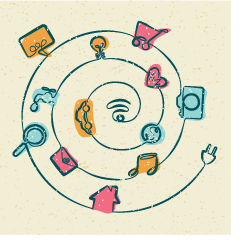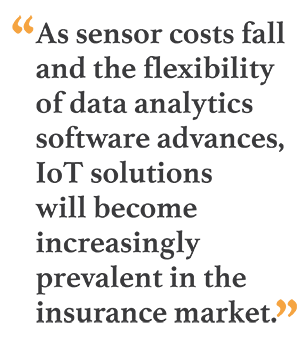 Last year, the rise of the Internet of Things (IoT) was covered by mainstream and tech trade media almost as closely as the U.S. presidential election.
Last year, the rise of the Internet of Things (IoT) was covered by mainstream and tech trade media almost as closely as the U.S. presidential election.
As consumers saw the potential for their myriad devices to become smarter and more tightly connected, businesses began investing in developing IoT capabilities. For example, refrigerators in connected homes are fitted with internal cameras so that homeowners can see how much milk is left, even while standing in the supermarket. For parents of teen drivers, the Hum "connected vehicle" device from Verizon Wireless provides text or email alerts if a vehicle exceeds a maximum speed, or if it moves outside a preset boundary area. Such devices aim to make consumers' lives easier and more efficient—and, in the case of the Hum, safer—while saving time and money.
Just as the universe of IoT devices, services, wearables, handhelds, and cloud-based software solutions is transforming the consumer experience, it's also beginning to transform the insurance marketplace. Old-line carriers and startup Web-based insurers alike are pursuing new technology offerings.
Recommended For You
So far, startup insurers have focused mostly on the consumer and small commercial marketplace, disrupting the agent/broker model to go direct to consumers. One of these is Lemonade, an insurer focusing initially on the homeowners and renters marketplace in New York City that has the backing of Google, Sequoia, and XL Innovate. Lemonade has raised more than $34 million in initial funding, bringing the company's total funding to date to more than $60 million. In 2011, another online startup, Esurance, was acquired by Allstate Insurance for nearly $1 billion, although it has yet to earn a profit.
Many of these startups, and some more mainstream insurers, are including some type of hook with IoT devices, driving reductions in premium costs based upon use. The Snapshot plug-in from Progressive Insurance monitors a driver's actions in order to reward good drivers with lower premiums. And Nest has partnered with a number of carriers to give a discount to policyholders who use its safety and security devices in their home, similar to discounts for having hardwired smoke/heat detectors and central station alarming.
Attacking the Biggest Costs
As carriers from Berkshire Hathaway to State Farm to Allstate battle it out in the consumer marketplace and the small commercial marketplace, many corporate risk managers for midsize to large enterprises are quietly seeking out IoT services that can attack their biggest risk management expense. They are using IoT technologies to reduce employee and customer accidents and the associated costs.
 For the past 50 years, commercial property/casualty insurers have competed primarily on price. Although carriers do try to differentiate themselves as experts in specific industries, their focus on competitive pricing has conditioned corporate risk and finance managers to focus on the fixed costs of their programs, which account for only 20 to 30 percent of their total cost of risk. Through this competitive bidding process, agents/brokers have been able to fully commoditize the fixed-cost components of a company's total cost of risk.
For the past 50 years, commercial property/casualty insurers have competed primarily on price. Although carriers do try to differentiate themselves as experts in specific industries, their focus on competitive pricing has conditioned corporate risk and finance managers to focus on the fixed costs of their programs, which account for only 20 to 30 percent of their total cost of risk. Through this competitive bidding process, agents/brokers have been able to fully commoditize the fixed-cost components of a company's total cost of risk.
The fixed cost of an insurance and risk management program will become more and more irrelevant as brokers, insurers, and other service providers bring IoT solutions to rapidly and permanently address the other 70 to 80 percent of a company's total cost of risk.
Suppose, for example, that a retailer incurs and retains losses of $3 million annually as a result of customer slip/fall claims. Meanwhile, it pays a $300,000 premium to an insurance carrier to access the insurer's claims-adjusting services and to provide excess coverage in the case of a catastrophic claim. Corporate finance and risk managers have traditionally focused mostly on reducing the fixed costs in a program—the premiums. But even if the retailer in our example can reduce the fixed costs of its program by 20 percent, through carrier competition coordinated by its broker/agent, the program will cost $240,000 in fixed premiums and will have the same $3 million in claims. Ultimately, therefore, the retailer's total cost of risk will fall by only 1.8 percent.
Significant Reductions in the Cost of Risk
With the advent of IoT, insured clients, brokers, and carriers are beginning to bring a laser focus to the largest piece of the liability pie: claims that result from their own number-one cause of loss—customer slips and falls, in the example above. If a company's broker can embed a proven IoT loss-reduction solution in a policy, then even if the insurance premium costs more, the insured company may realize significant and permanent reductions in its total cost of risk.
In the example of the retailer, suppose that its insurance premium actually increased 10 percent, to $330,000, but that the new policy included a carrier-deployed IoT strategy that produced a 20 percent reduction in customer accidents, to $2.4 million. Even though the premium was higher, the total cost of risk for this client would be reduced by 16 percent, to $2.73 million with the IoT solution, versus $3.24 million in the traditional broker-led carrier competition. Thus, in this example, paying an additional $90,000 in premium to a carrier with an IoT solution would result in a dramatic and sustainable reduction in total cost of risk.
Insurers are applying a host of different IoT-related technologies to reduce the number of claims their clients face. Sensors are simultaneously growing more complex in their application, far less expensive, and more easily adaptable to everything from machine vibration to the working height of a construction worker. Applications that are just now emerging will enable corporate risk managers to quickly and permanently reduce their total cost of risk by monitoring the activities and/or employee behaviors that lead to their desired outcomes.
Recently, Hartford Steam Boiler, a provider of equipment-breakdown insurance, invested in Augury, a predictive machine diagnostics company. Using vibration and ultrasonic sensors, Augury's platform "listens" to equipment and uses proprietary analysis and algorithms to determine whether a machine is working properly or has a malfunction. Augury is starting with diagnosing heating, ventilation, and air conditioning (HVAC) systems in commercial buildings. By identifying maintenance needs and areas of vulnerability in insured machinery, the Augury technology has the potential to save billions of dollars for insurers like Hartford Steam Boiler and their clients.
Sensors and IoT tools are also rapidly expanding their footprint in the retail space, particularly in the food industry. Supermarket and restaurant-industry operators are searching for ways to become more efficient in complying with record-keeping and food safety laws driven by the Food and Drug Administration, the United States Department of Agriculture, and local and state health agencies. Software vendors have recently begun to emphasize the chain of custody of food. Sensors placed in trucks, rail cars, and airplanes can create a record that shows whether freight carriers have handled the food in an environmentally safe manner. And sensors placed directly in the shipping containers can measure the temperature of the product throughout its life journey.
Unfortunately, safety monitoring often stops at the back door of the restaurant or supermarket, because operators do not have the required skills to use sensor-based technology indoors. This is where insurance carriers and brokers can provide a value-added service to their clients: As specialists in risk-mitigation strategies, carriers and brokers need to help companies integrate sensor-driven data, in real time, into actionable operational information that corporate management can use to monitor desired behaviors and imperatives. Measuring employee compliance with inspections that are business-critical, required by law—or both—can help an organization achieve an immediate and sustainable reduction in the number and severity of customer and employee accidents.
For the food industry, technology vendors are working to simplify regulatory compliance through platforms that automate alerts for problematic temperature conditions in food-storage areas, and that document compliance with all levels of required inspections. Businesses that monitor employee and third-party practices in real time can enforce and document compliance. This means that restaurants, for example, are less likely to face foodborne-illness claims—claims that are not only costly in terms of lawsuits related to food poisoning, but also highly damaging to the corporate brand. Just ask Chipotle.
By increasing internal and external compliance rates, lowering risk, and minimizing claims, IoT technologies have the potential to substantially reduce the total cost of risk for companies in the food industry, the retail sector, manufacturing, and beyond.
Next Steps
For corporate finance and risk managers, here are some next steps in determining how the IoT might benefit your risk management practices:
- Begin a conversation with your broker regarding the rapidly evolving practice of using IoT solutions to solve specific risk issues. Ask what IoT solutions are available to bring down risk management costs for businesses like yours. Consider requesting a similar briefing from insurers that profess to be experts in your industry.
- For any proposed IoT solution, get true empirical evidence that it works. It's best if the evidence comes from an independent third party or university-supported study.
- When evaluating your insurance and risk management program, consider seeking service-level agreements that target specific reductions in your number-one cause of losses, based on your successful commitment to—and execution of—an IoT-based loss prevention program.
- Consider asking your insurance carrier for a multiyear commitment based on successful implementation of its IoT-based strategy.
- Speak with your peers about innovation within your industry and about what they may (or may not) be doing in the deployment of risk mitigation solutions.
- Speak with your industry association to find out what they are seeing in the way of risk mitigation strategies.
- Remember to focus on solutions that solve the big problem, such as general or workers compensation claims. You may want to pay more for a turnkey solution that is proven to reduce losses.
As sensor costs fall and the flexibility of data analytics software advances, IoT solutions will become increasingly prevalent in the insurance market. The challenge for everyone involved in an insurance transaction—broker, carrier, and insured client—is how to evaluate the IoT solutions that are part of an insurance offer.
 Rooney Gleason is president of U.S. Grocery and Retail for Argo Group, an international underwriter of specialty insurance and reinsurance products in the property and casualty market. Gleason has spent 25 years in the insurance and risk management business, providing customers with cutting-edge, paperless, real-time solutions for assuring operating compliance in areas of risk and safety management, food HAACP, and compliance auditing.
Rooney Gleason is president of U.S. Grocery and Retail for Argo Group, an international underwriter of specialty insurance and reinsurance products in the property and casualty market. Gleason has spent 25 years in the insurance and risk management business, providing customers with cutting-edge, paperless, real-time solutions for assuring operating compliance in areas of risk and safety management, food HAACP, and compliance auditing.
© Touchpoint Markets, All Rights Reserved. Request academic re-use from www.copyright.com. All other uses, submit a request to [email protected]. For more inforrmation visit Asset & Logo Licensing.



